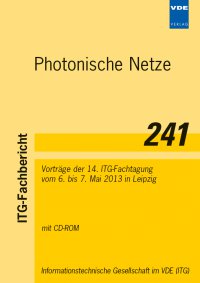Increasing the storage time of Quasi-light storage by reducing the Brillouin gain bandwidth in a feedback system
Konferenz: Photonische Netze - Vorträge der 14. ITG-Fachtagung
06.05.2013 - 07.05.2013 in Leipzig, Germany
Tagungsband: Photonische Netze
Seiten: 5Sprache: EnglischTyp: PDF
Persönliche VDE-Mitglieder erhalten auf diesen Artikel 10% Rabatt
Autoren:
Preußler, Stefan; Schneider, Thomas (Institut für Hochfrequenztechnik, Hochschule für Telekommunikation Leipzig, Gustav Freytag Str. 43-45, 04277 Leipzig, Germany)
Inhalt:
The core elements of optical packet-switched networks rely on optical routers. A key technology for the realization of such components is the variable delay and storage of optical data packets. Optical Memories are used for tasks, such as packet buffering for collision avoidance and synchronization, as well as processing of headers in optical routers. The quasi-light storage (QLS) is a method for the variable and almost distortion free optical data storage, which can be realized within the entire transparency range of optical fibers with standard telecommunication components. QLS is based on the time-frequency-coherence and utilizes stimulated Brillouin scattering (SBS) for filtering the spectrum of the data signal. Due to the natural bandwidth of the SBS, the maximum storage time of the QLS is limited to 100 ns. By reducing the bandwidth, the storage time can be significantly increased. There exist some approaches for reducing the SBS bandwidth. Firstly, the Brillouin gain can be superimposed with two losses and secondly, an aperture in the frequency range can be used. Both methods achieve a SBS bandwidth of about 3 MHz, but have some disadvantages when applied to the QLS. For the superposition method, the overall gain is too low, and for the other method the aperture cannot be separated from the signal. In this paper we show the reduction of the Brillouin gain bandwidth through a feedback system. The sampled signal passes several times through the system, so that the Brillouin gain bandwidth is reduced. This leads to a drastic increase of the QLS storage time. In a first experiment with single pulses, a maximum storage time of 600 ns was achieved, which corresponds to a sixfold increase compared to a normal system QLS.


